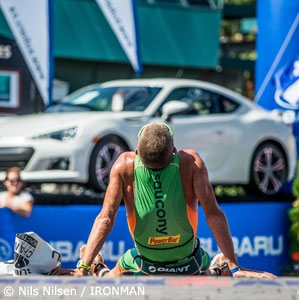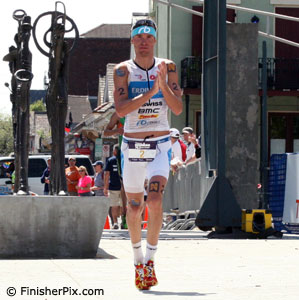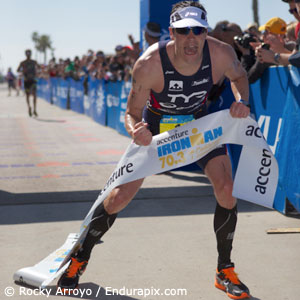A dark horse breaks through
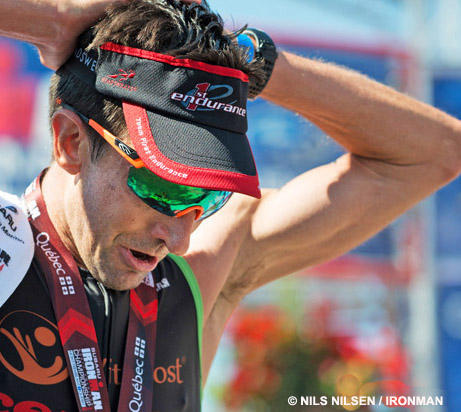
Brandon Marsh has been doing triathlons for 25 years and is in his 10th season as a professional. Five years ago, he was earning far more 10th and 12th places than podiums and was questioning whether or not he had anything more left in the tank. But when he signed on with coach Paulo Sousa two years ago, things started to look up. Gradually and inexorably, they started putting everything together.
It was subtle at first. In 2012 he took a 5th at Ironman Texas and a 6th at Ironman Cozumel with his usual first pack swim, 4:35 bikes splits that were 10 minutes off the day’s best, and right on a 3-hour marathon. In March of 2013, he took another 5th, but his performance at Ironman 70.3 California stacked up much better against a top field. His swim was first pack a usual, but his 2:15 bike split was within seconds of winner Andy Potts. His 1:13:00 run was fast – and within 2:30 of the best on the day.
Throughout the year, Marsh stayed away from podiums in 70.3s and off the radar – but he was getting stronger in training every day and finally put all his chips on the table at the prestigious Ironman North American Championship at Mt. Tremblant. He believed so strongly in himself, he counted on advancing from a remote 83rd place in the Kona Qualifying points to earn one of the 10 spots left open in the August qualifying period.
When the racing was over, Marsh posted a race-best 47:45 swim, 8th-fastest 4:41:04 bike split and 3rd-quickest 2:56:24 run. He shocked a talented men’s field with a second place finish, 4:55 behind men’s winner Luke Bell, that earned him 3,520 Kona Qualifying points and vaulted him to 16th in the KPR rankings. It was probably the best and most important race in his long career.
Marsh tells how he earned his place on the start line at Kona in this interview via email from his training base on Flagstaff, Arizona.
Slowtwitch: What did your 2nd place finish at Ironman Mt. Tremblant mean to you?
Brandon Marsh: To me, it was validation that I've got the big performances in me as well as a bit of validation of the work that 'Team-Marsh' [Brandon and his accomplished pro triathlete wife Amy] has put in over the last years.
ST: Did you formulate your 2013 race schedule with this race and the points in mind?
Brandon: Yes and no. Amy and I try to set up our schedule to include races that we want to do as well as races that will let us race together and reach our goals. For me this year, I wanted to do a couple of Rev3 races as well as several WTC events. Primary was to put together a good race at an Ironman. There were only a couple of IM 140.6 events that I wanted to race and Mont Tremblant was one of them. I also wanted to do one Ironman in this calendar year to go with my 2012 Ironman Cozumel score — with a secondary goal of getting to Kona.
ST: If so, what race, or races, did you rule out to focus on Mt. Tremblant?
Brandon: With the KPR [Kona Pro Rankings], it really only made sense for me to look at the P-2000 races or the P-4000 at IMMT [Ironman Mt. Tremblant.] The only P-2000s that I considered were Ironman Texas and Ironman Coeur d’Alene, but IMTX would have eliminated Rev3S at Knoxville and Quassy. And, I didn't want to feel like I needed to do a second race in this calendar year to get to Kona. So all the eggs went into IMMT.
ST: What sort of specific training did you do to prepare for this challenging bike and run course?
Brandon: None really. By that I just mean that the majority of my rides were hilly and I tried to pick some rolling runs. We've been in Flagstaff, AZ so there are some pretty good rides and runs there. In the last month or so leading in to the race I did try to find long rides that approximated the same amount of vertical on the bike.

ST: Have you done Ironman Hawaii previously as a professional?
Brandon: I have not. I'm not getting any younger and the fields aren't getting any slower, so I thought this year might be a good try.
ST: Obviously I was way off by leaving you out of the top candidates in my preview of this race. Michael Lovato was right on in his predictions that you would contend for the win. What in your previous finishes this year — 5th at Oceanside, 4th at Ironman New Orleans and 7th at Vineman 70.3 – indicated that you had a big breakthrough coming?
Brandon: Thanks to [Ironman.com commentators] Michael Lovato and Matt Lieto for putting me in a predicted 4th and as a 'dark horse.' I think the main thing was simply the caliber of the competition at the earlier races combined with my finishes. They were good results in races that had good fields. There were good athletes ahead of and behind me. To me, that's an indication that the training, the lead in to the race, etc. are all pointing to what should be a good race.
ST: Why were you confident coming into this race?
Brandon: It was a combination of things. Certainly the results helped as mentioned above. I've raced pro since 2004, but only in the last few years have Amy and I really focused on setting up our lives and lifestyles to be the best pro athletes that we can be. Again, I think that along with the consistency of training, the results from 2012 and the first part of 2013 just added to my confidence. Paulo had his Triathlon Squad in Flagstaff earlier this summer. I trained with his ITU guys and regularly was the caboose on the runs. But really it was a very good generalized block of training that gave me some good confidence that I was making gains that I wouldn't have made on my own.
ST:: What did Paulo Sousa tell you about strategy and timing of your moves for this race?
Brandon: If you race enough, you kind of know at least a little of how the race will unfold especially if you're in the front bunch out of the water. So, Paulo and I talked about the plan that would set me up best for a good race. It included some power numbers and pace goals for the run. But at the end of the day, it was up to me to execute the race and make the moves at the right time. With Paulo, we don't necessarily talk about specific strategy like who to key off of, etc. I've got a lot of racing experience, so he said to use that. We talked more about the specifics on race execution. We have really worked on focusing on the day to day. Making sure that I'm doing the best I can each day, being positive but not in a cheerleader way, and making good choices daily and on race day.
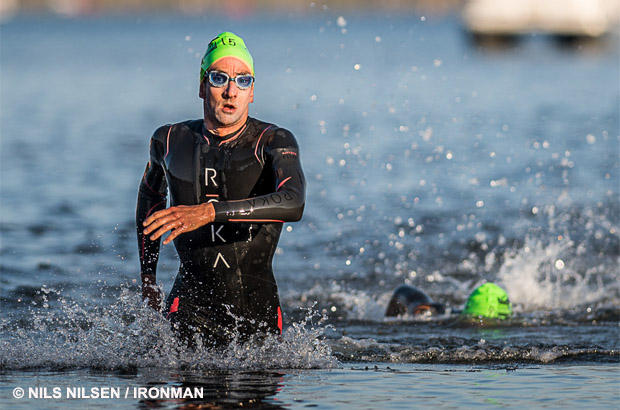
ST: Michael Lovato said that when you crossed the line at Mt. Tremblant with your best-ever performance at a prestigious Ironman, you said something to the effect, ‘Dang it! I was so close!’ Meaning that you believed you had a chance to win at the end. Lovato saw this as an affirmation of how ready you were for this race.
Brandon: Expected to win? No, not with the field that was there. There have been stronger ones, but this one was good and there were a lot of capable athletes on the starting line. But, really I was ready for this race and knew a good performance could have meant a win. I think to expect to win can lead to the possibility of failure or at least that expectation can cloud your judgment on race day.
ST: Lovato said he had been watching your races for the last few years and said you either had a great bike and a slow run, or a slow bike and a great run. But at Ironman Cozumel and in your top performances in the 2013 70.3 races, you found a way to balance the two legs out and have excellent bikes and runs in the same race. True?
Brandon: Well, in the last 4-5 years I had a couple of slower years in there with a string of 10-12 place races and was asking myself it that was all I had in me…and I really thought that I was a better athlete than that. At the end of 2011 I reached out to Paulo to help me tweak my build for IM Cozumel that year, and I went 7th. At the beginning of 2012 Paulo started coaching me full time. So, really I just turned the reins over to him. Our personalities meshed well, the program has been really solid, and I've been very consistent. That sounds a bit cliché, but it's pretty much how it went. So, it has been a combination of what I think is a really good program and Paulo challenging me to do better, as I mentioned before, in the daily. At this level, you need to be about performance. And sometimes that means hearing things you might not like to hear or doing things you might not like to do. And, it really helps to see the good results of athletes like Trevor and Heather Wurtele, Jen Spieldenner, Joe Maloy and the other Triathlon Squad athletes — that helps with the confidence as well.
ST: Looking for signs you were about to unleash this great race, I saw at Ironman 70.3 New Orleans you ran 1:15:07, just 1:20 off Andreas Raelert. At Vineman you ran 1:14:33, just 2 minutes off Gambles and Docherty. Did those runs show you were ready to make the podium at the high pressure top rated Ironman field at Mt Tremblant?
Brandon: Clearly those runs, combined with a couple from last year, showed that the training and approach was working. And even the rides, but again a lot of that is a bit of pack dynamics and race dynamics on the ride. But to immediately say that a 13.1 mile run is going to translate to a 26.2 mile run can be a stretch. When I added those performances to my training with the Triathlon Squad for a few weeks in Flagstaff as well as my last weeks of my Ironman build, I was confident that if I did my part with race execution, nutrition, etc. that I'd run well.
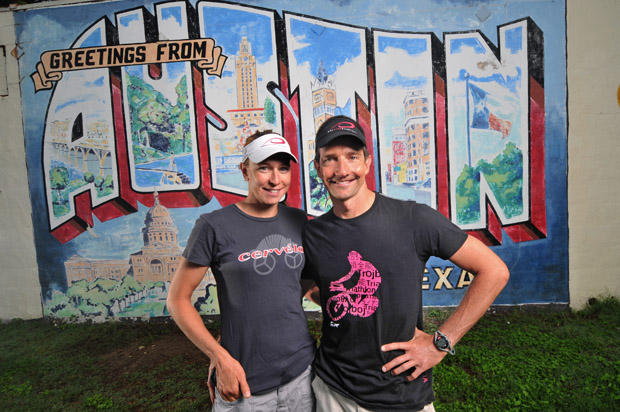
ST: I see you came out of the swim with the lead pack just at 48 minutes. Where did Bell and company get away on the bike to lead you by 4 minutes at T2?
Brandon: You know I was off the back early in the ride, probably by about 45-60 seconds. I had a helmet snafu and that cost me a bit of time, but then I was kind of sticking to my plan. I ended up rolling up to the group about 30k in. At about 60k, a gap opened a few riders up and that's where the split happened. After the first loop, everyone except for Rhodesy [Bryan Rhodes] in the group I was in seemed to be content to cruise on their bikes, so I drove our group and with Bryan Rhodes help held the gap to about 3 minutes for the next nearly 60k. We lost some more time in the next 30k and then Bert Jammaer came on hard and Bert and Rhodesy decided to ride the last 20k harder than I was prepared to, so the gap to me swelled to 4+ minutes.
ST: By 16k into the run, Bell made his move and had 7 minutes on you. How had you run thus far and how were you feeling? Were you nervous about the increasing gap?
Brandon: I think at the upper end of some of the pro races, everyone can run a fast first 10 or 20k. It's after that that changes tend to happen. So, I just had to settle in to my pace and go from there. The course at IMMT is deceivingly difficult. Again, for this one, focusing on what I was prepared to do was the key.
ST: By 30k into the run, Bell led Jammaer by 4:12 and you by 4:22. When had you passed the intervening runners?
Brandon: I think that the big changes started after halfway when I passed Dan Halksworth to move into 6th. After that is was one after another with a pass on Romain [Guillaume] a bit before 30k. I could see Bert ahead, but he was coming back slowly.
ST: With a decreasing margin to Bell at 30k into the run, did you sense you might take Bell down? Did you increase your pace?
Brandon: I was running blind in regards to where I was in relation to Luke. After I passed Bert with 8k to go, I just really focused on maintaining my 2nd position. That late in the run, it really was about doing my best to maintain my pace. Late race passes usually stick, but you never know.
ST: If or when did you think that Bell had wrapped up the win?
Brandon: I saw Luke with about 6 or 7k to go and he had over 4 minutes. At that point, I figured he had it in the bag. It wasn't until after the race that I found out that he cramped a few times. If I had been within seeing distance, it might have made a difference, but 4-plus minutes in 5k is a lot of time.
ST: Near the end, things were close for 2nd and 3rd. When exactly did you pass Jammaer and was he able to fight back?
Brandon: It was about 8k to go that I passed Bert. I kind of felt like the wheels were starting to fall off with 5k to go, so I was grabbing coke, water, whatever to keep going! I thought a couple of times, ‘What if I went too early?’
ST: How hard were you pushing the last mile to keep Jammaer from coming back on you?
Brandon: The last miles were definitely the hardest, they always are. Again, just trying to maintain pace, or at least not slow down too much. Within the last half mile or so, I saw that Bert was about 30 seconds back, so I was pretty sure then.

ST: What did Amy say to you afterward?
Brandon: I talked to her on the phone and she said, ‘You're my hero! I am so proud of you!’
ST: Was this your greatest race?
Brandon: I think that this was my best race to date as a professional, with the 2013 California 70.3 being a close 2nd. Having raced hundreds of events since 1989, it's hard to put a greatest on any single event. But, yes this is one of my best races.
ST: What is the biggest misconception about you as a triathlete?
Brandon: I don't know, really. What are people saying out there? Good or bad I think that I'm pretty direct on things, and I think that I've got a fair bit to offer from the pro perspective as someone who has come up through the ranks.
ST: What do you think you can do at Kona? Can you swim and ride with the leaders? Is your run strong enough to make the top 10? Top 5? Better?
Brandon: That's a loaded question. Kona is a collection of the best athletes. Can I swim with the leaders? Yeah, the lead pack for sure. Ride? That's always a question for most pros. There are too many examples now of guys who overestimate their ride/run abilities and it bites them. But, the race dynamics are so different now than the Mark/Dave or Tim/Peter years, so you have to take some calculated risks and it's usually on the bike. I can't think of too many people who would have picked [me] the top-10 in the last couple of years. The run? To think that a 2:56-ish on a difficult course is suddenly going to translate into a sub-2:50 might be a bit of an overstatement. The unfortunate thing about Kona is finishing 11th gets you nothing. So, obviously top-10 would be the 'A' goal. Maybe some think that is selling myself short, but really I think that's the goal of a lot of pros going to Kona. I certainly think that a top-15 or top-20 result is in reach — and that's about the worst place you could be financially. But, Kona is a bit of a bucket list, so we'll see.
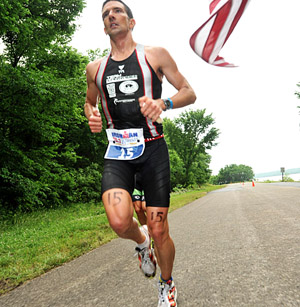
ST: What were the most important factors in making you ready to have a great day for this race?
Brandon: For me it was the months leading in. It was having a pretty well laid-out plan on race day. It was focusing on the process in the short and long term leading in to the race. It was being present on race day and focusing on what I trained to do. That all sounds a bit nebulous, but really that's what it took for me. Focus on my long rides and runs. Setting up my days and weeks to be the best pro that I could be. Trusting and believing that the work that I put in before race day was there.
ST: What was your key decision made in the heat of battle at Mt. Tremblant?
Brandon: I really think that once the front group went off, it was focusing even more on what was going on for me the rest of the day. And worrying less about what went on ahead of or behind me.
ST: Where will you train for Kona?
Brandon: We have been in Flagstaff, Arizona since early June. We will likely stay here through Kona though we have not written off a shift to somewhere like Vegas or St. George for the last block of training, somewhere lower in altitude and warmer. The Flagstaff altitude (7,000 feet) works really well for me and pretty well for Amy, so we'll see what will be the best combo. We'll definitely travel down to Sedona or Camp Verde in Arizona for some rides and runs at lower elevations and to get a bit more heat when it cools off up here. We will likely be on the broom wagon into Kona and arrive late, Wednesday or so before the race.
ST: Any more races before Kona?
Brandon: Doubtful. It's only 8 or so weeks away. If Paulo and I think it makes sense, I might think about a mid-September race like Rev3 Branson, but my focus right now is getting recovered and getting Amy prepped for 70.3 Worlds in Vegas.


